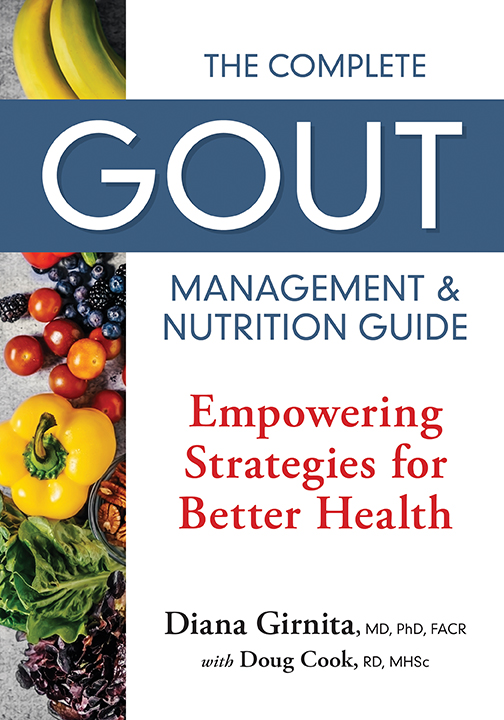Fundamentally, there are many differing opinions on when and how to treat gout, even among highly regarded experts. The complexity of the disease is significant. Physicians have been treating gout since antiquity, but for centuries they had no idea what triggered an attack. It wasn’t until the 1960s that researchers identified the direct perpetrator, too much uric acid in your body.
I see the results of this uncertainty in my daily practice. Gout is a common disease, but it’s likely to be misdiagnosed and/or mismanaged. A patient’s first response to the symptoms is probably to book an appointment with their family physician. Unfortunately, some primary-care providers don’t know how best to treat gout. They may confuse high uric acid levels in the blood with the condition. They may also be unsure about whether to treat the pain or initiate long-term therapy.
Gout is a common disease, but it’s likely to be misdiagnosed and/or mismanaged. Our current medical system also makes treatment challenging. Even if your family physician has the best intentions, they don’t have time to discuss long-term management in the standard 10-minute visit. An emergency or urgent-care consultation is equally problematic, as a one-time visit doesn’t include a comprehensive evaluation or follow-up. For many reasons, which I’ll explain later, making an accurate diagnosis of gout can be complicated. Basically, the earlier you begin proper treatment, the better your outcome is likely to be.
If you have gout, you need to see a specialist as quickly as possible. While experts agree on how to treat gout, they debate the impact that food and lifestyle can have in its management. One active debate revolves around the benefits of pharmaceutical interventions compared to lifestyle modifications such as changes to diet. There is no question that drugs are effective in the acute phase of an attack. They work quickly, providing immediate pain relief. But long-term management of the condition requires a more comprehensive approach.
If you are suffering from gout, it is likely you will encounter a specialist who will tell you there is no scientific evidence linking what you eat to an attack of gout—even if your experience shows a clear connection. There are many reasons for this. One, generally, doctors have minimal education in nutrition. We have been trained to recognize and diagnose a disease, then treat it with medications. Also, there is a sad lack of “gold standard” studies linking nutrition with gout. Usually, we as physicians do not talk to patients about nutrition or supplements, even when patients initiate the discussion. We are afraid to make recommendations, as this information is outside the rules governing the standard of care. Most of our recommendations are very general: “Don’t eat too much protein. Don’t drink too much alcohol. Sleep well and exercise. Avoid stress.” How is that advice supposed to help patients? If we don’t give patients a plan to follow, our advice is just a wish list.
Yes, medication has an important part to play in treating gout. But as a researcher and a rheumatologist who has been treating patients with gout for 10 years, I know that nutrition has a major role to play in the long-term management of gout. You can’t successfully manage the disease without involving diet. Nutrition has a major role to play in the long‑term management of gout.
I became a rheumatologist via a circuitous route. In 2005, as a cardiology resident, I was invited to pursue a postdoctoral fellowship at Harvard University to study heart disease. A year later, at the University of Pittsburgh, I investigated the relationship between our genes and the immune system. One fundamental lesson I learned there is that our genes influence how our bodies react to inflammation; if you are predisposed to develop more inflammation, it is mostly because of your genes. I enjoyed my research work but, after five years, I was missing direct interaction with patients. I took the plunge and undertook further training to become a board-certified specialist in internal medicine and rheumatology. Since then, I’ve evaluated many patients with gout and have learned first-hand how much misunderstanding there is about the disease as well as how frequently it is misdiagnosed and poorly managed. Over the years, patients often asked me about nutrition. I felt frustrated, as I did not have all the answers. I started to study how certain foods, supplements and lifestyle changes could affect gout. I went back to school and studied nutrition science at Stanford University, then did further research into mindfulness at the University of Massachusetts. Since then, I have spent hundreds of hours researching the topics I discuss in this book.
My practical experience made me aware of another problem. Accessing specialists in the United States is very difficult. Recognizing that patients who are in pain and need immediate help can easily wait four to six months to get an appointment with a rheumatologist, I started my own practice, Rheumatologist OnCall. Through my company, patients can reach me from their homes via telemedicine anywhere in the United States.
I wrote this book because I wanted to clarify the confusion about gout and to help people who are suffering from the disease. Gout is more than an acute attack that subsequently goes away. It’s a much deeper problem involving your entire metabolism. Gout is strongly connected with numerous metabolic diseases, including obesity, diabetes, psoriasis and hypertension. Left untreated, it will leave its mark on your entire body, damaging organs such as your heart, blood vessels and kidneys. Gout is strongly connected with numerous metabolic diseases, including obesity, diabetes, psoriasis and hypertension. I felt compelled to write this book because I see so much unscientific information about nutrition being bandied about. These days many “experts”—some of whom have never treated a patient in their life—dispense all kinds of misguided advice across multiple social media platforms. When it comes to nutrition, I want to set the record straight. In this book, I share what I know about the scientifically proven dietary interventions that will likely help you prevent onset of gout and decrease the frequency of gout attacks.
Many patients who come to see me want to know what they can eat. That’s not a simple, one-size-fits all answer, in part, because our unique genetic makeup affects how we process food. Our genes influence our immune system, raising the risk of inflammation in certain individuals. That means if someone who is genetically vulnerable eats a food that is wrong for them, it will probably spark inflammation and increase the frequency of gout attacks. Patients know enough about nutrition to recognize that they need to change their diet and lifestyle, but they need guidance. And that’s what this book can provide. It is intended to be a bridge between nutrition and lifestyle interventions and pharmaceutical options. It recognizes that these solutions can co-exist. They should complement, not exclude each other, leading to a better outcome. With the help of this book, you can live a better life with the least amount of medication. In this book, I tell you everything you wanted to know about gout, from how to identify the disease to the various treatments available. I also teach you about foods and their relationship with gout. You may know that certain foods can trigger a gout attack, but you may not be aware that eating other foods can help with controlling the disease. You will learn how to identify the foods and lifestyle choices that work for you—putting you in the driver’s seat managing your gout.
Finally, I provide some practical tools for keeping gout at bay. These include detailed instructions on how to keep a food diary as well as a 30-day meal plan with delicious recipes. Many factors have contributed to your gout, and no standard- issue approach is going to fix your problem. We can’t cure your gout, but we can improve your quality of life and prevent the disease from further damaging your body. This book will tell you what you need to do to help you understand your condition and live a more enjoyable life.
Is this book for you?
- If you are newly diagnosed with gout, this book will fully explain the condition— what it is and how you can take control over it.
- If you are a long-suffering gout patient who seems to spend too much time in severe pain, it will equip you with a fresh perspective, providing information that will help you reduce the frequency of your attacks and downscale their severity.
- If you have a family member with gout or you are caring for someone with the disease, it will help you to understand their experience and provide you with supportive tools.
This book is not about how to cure gout but rather how to manage it better and avoid future complications. It is intended to be a bridge between nutrition and lifestyle interventions and pharmaceutical options.




